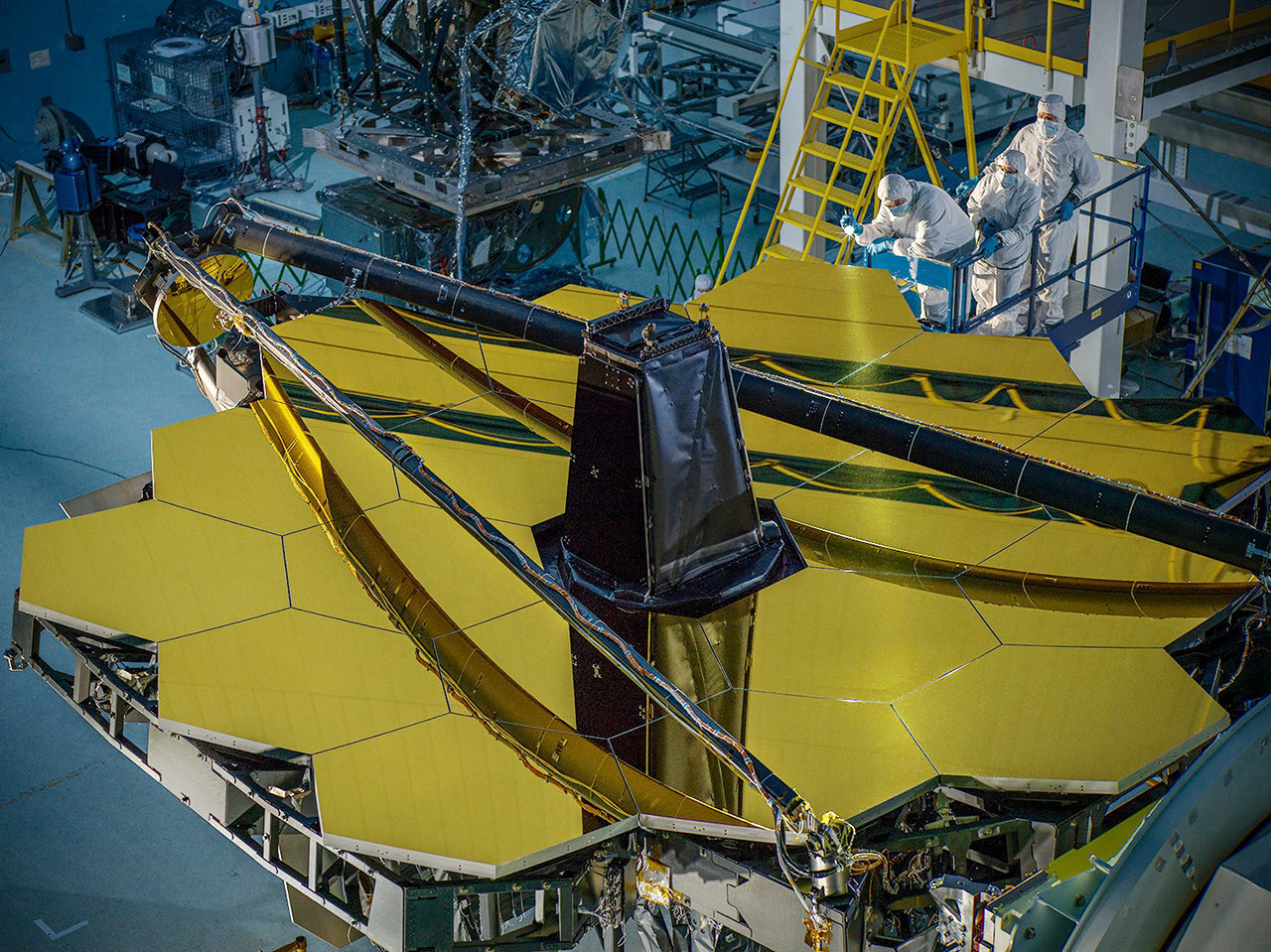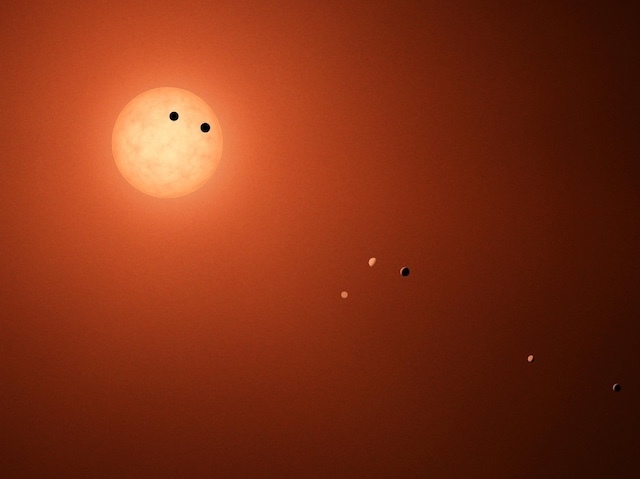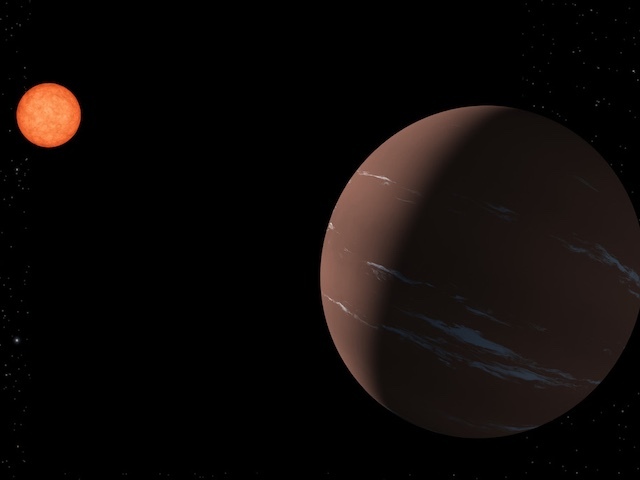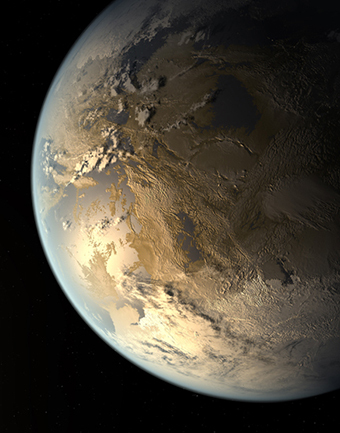News | July 18, 2016
The next generation of telescopes are almost impossibly accurate

At a Goddard cleanroom, technicians unveil the James Webb Observatory’s segmented mirror in preparation for an alignment test this summer. The tool used to determine the segments’ alignment has inspired Goddard technologists to create another that offers picometer accuracy for next-generation observatories. Credit: NASA/Chris Gunn
Finding and characterizing dozens of Earth-like planets will require a super-stable space telescope whose optical components move or distort no more than a few picometers — a measurement smaller than the size of an atom. It also will require next-generation tools with which to assure that level of stability.
With NASA funding, a team of scientists at NASA’s Goddard Space Flight Center in Greenbelt, Maryland, has begun working with an Arizona-based company to develop a highly sophisticated laboratory tool — a high-speed interferometer — capable of assuring picometer-level stability, a feat not yet accomplished.
To date, NASA has yet to launch an observatory with such demanding stability requirements. However, the scientific community is studying the possibility. Last year, the Association of Universities for Research in Astronomy endorsed the High-Definition Space Telescope. It found that with proper stability and instrumentation, a 33-39 foot (10-12 meter) telescope could find and characterize Earth-like planets. Another study group evaluating a similar concept known as the Large Aperture Ultraviolet-Optical-Infrared Space Telescope, or LUVOIR, has reached similar conclusions.
If the agency wants to search for and analyze Earth-like planets in other solar systems, the telescope it designs and builds will have to be orders of magnitude more stable than anything launched to date, including the James Webb Space Telescope.
The most precise tool
To help NASA reach this next level of precision, Saif and his Goddard colleague, Lee Feinberg, have begun working with 4-D Technology, of Tucson, Arizona, to develop the instrument.
Like all interferometers, the instrument would split light and then recombine it to measure tiny changes, including motion. With this tool, technicians would measure distortions in mirror segments, mounts, and other supporting telescope structure primarily during thermal, vibration, and other types of environmental testing.
See more: Inventing the Future
Displacements and movement occur when materials used to build the optics shrink or expand due to wildly fluctuating temperatures, such as those experienced when traveling from Earth to the frigidity of space or when exposed to fierce launch forces more than six-and-a-half times the force of gravity.
If optics must conform to a specific prescription to carry out a challenging mission, even nearly imperceptible, atomic-size movements caused by thermal and dynamic changes could affect their ability to gather and focus enough light to distinguish a planet’s light from that of its parent star — to say nothing of scrutinizing that light to discern different atmospheric chemical signatures, Saif said.
The most powerful observatory ever built
The effort leverages a similar instrument that 4-D Technology created to test the optics of the Webb Observatory, which will be the most powerful observatory ever built once it launches in October 2018. From its orbit 930,000 miles from Earth, it will study every phase in the history of our universe, from the first luminous glows after the Big Bang to the evolution of our own solar system. Among many other firsts, Webb will carry a 21-foot primary mirror made of 18 separate ultra-lightweight beryllium segments that unfold and adjust to shape after launch.
To carry out its job, the Webb Observatory also must be highly stable. However, the movement of its materials is measured in nanometers — the unit of measure that scientists use to determine the size of atoms and molecules.
“What we did was measure the surface of each mirror after each environmental test to see if we could see changes,” Saif said. “I started questioning, what if something behind the mirror moves. Just measuring the surface isn’t enough.”
To assure nanometer-level stability — 4-D Technology worked with the Webb Observatory team at Goddard to develop a dynamic laser interferometer that instantaneously measured displacements in the mirror segments as well as those in their mounts and other structural components, despite vibration, noise, or air turbulence.
“The high-speed interferometer actually enables you to do nanometer dynamics for large structures,” Saif said. “This is absolutely new. The instrument is four orders of magnitude more sensitive than other measurement tools and it measures the full surface of the mirrors.” That instrument now is used in laboratories, manufacturing areas, clean rooms, and environmental-testing chambers operated by the project’s major contractors.
Next-generation
However, a next-generation LUVOIR-type mission will demand even greater stability, and consequently an instrument capable of quickly measuring picometer displacements, which are two orders of a magnitude smaller than an atom. Although it is possible to calculate picometer movements with existing tools, the physics are non-linear and the resulting calculations might not accurately reflect what actually is going on, Saif said.
“Every subsystem needs to be designed on a picometer level and then tested at picometers,” Saif explained. “You need to measure what you’re interested in and the instrument needs to calculate these motions quickly so that you can understand the dynamics.”
The team is developing the tool with $1.65 million in funding from NASA’s Cosmic Origins Strategic Astrophysics Technology program. It expects to complete the work in four years.
For more technology news, visit:








